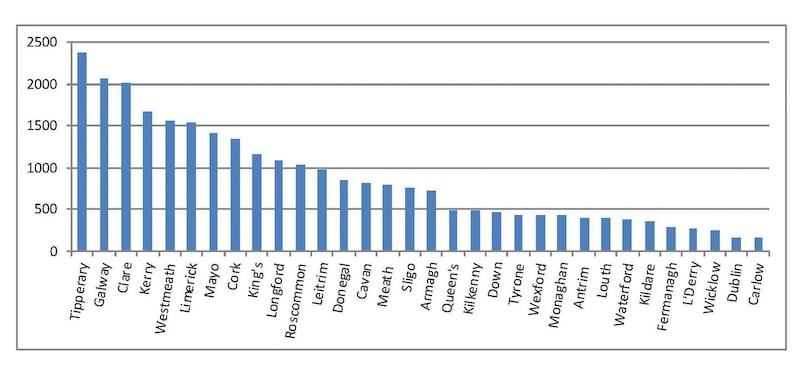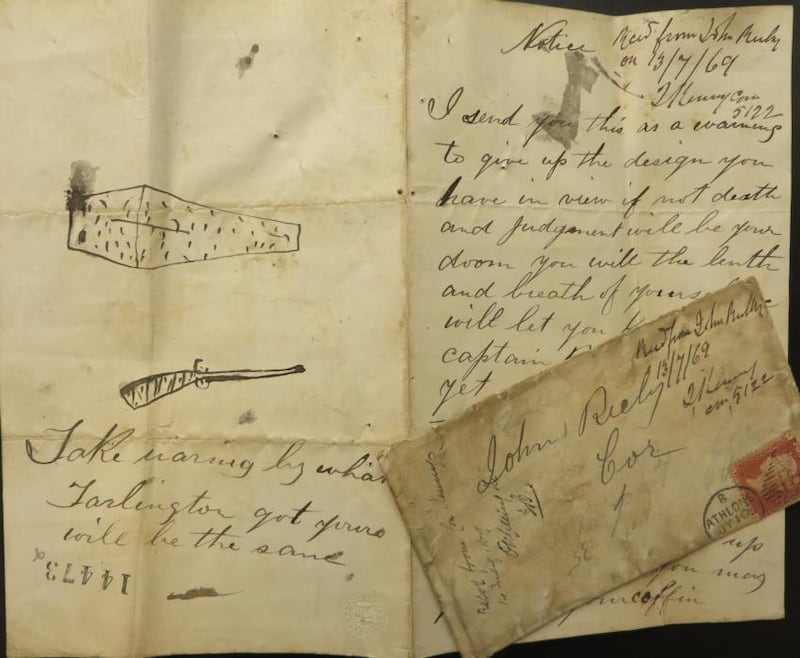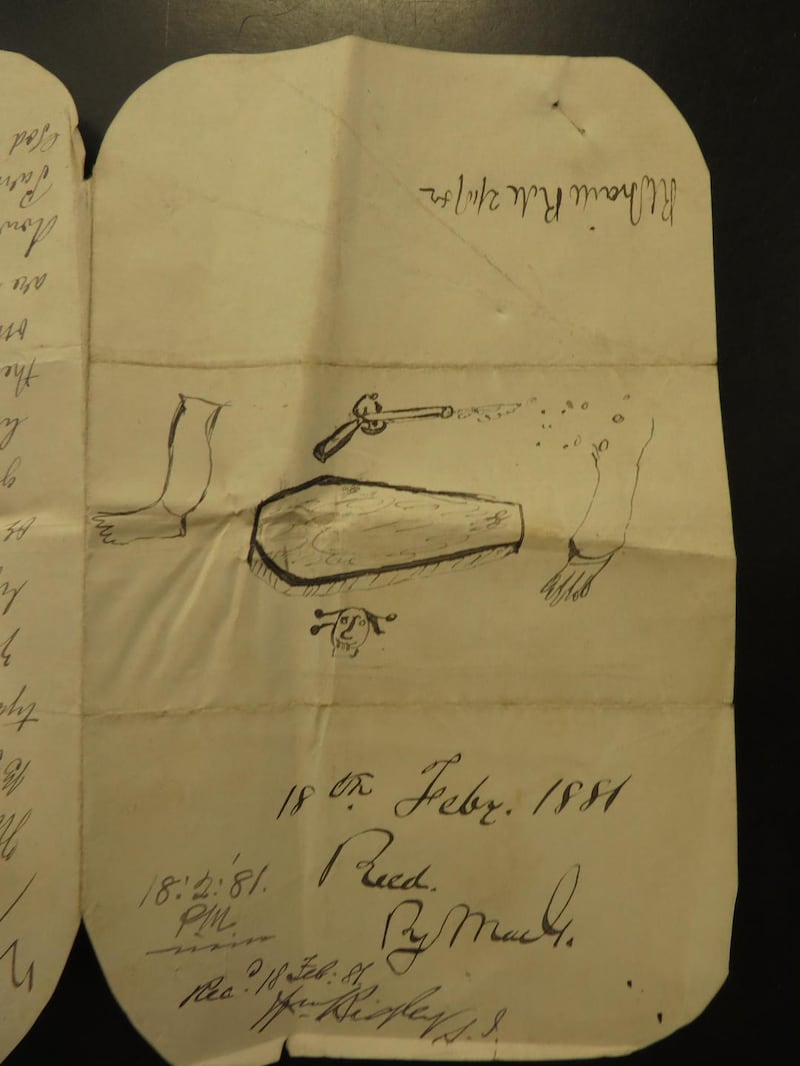The simple rural pastime of intimidating one’s neighbours may not be uniquely Irish – but the practice of distributing threatening letters and notices, whether via the penny post or nailed to barn doors, was the scourge of Victorian Ireland. Annually thousands of these epistles were handed in to police stations and dutifully recorded for posterity under Outrages.
Sometimes these letters were destroyed by the indignant victim (though a copy might be made first), but the evidence points to their generally being kept – as if it were a bad omen to burn the hated document.
The hapless Captain Boycott admitted having a writing cabinet crammed full of them. Land agent Samuel Hussey boasted, “threatening letters count for nothing. I have had over one hundred in my time, yet I’ll die in my bed for all that,” (which he did).

There was a sameness about the content of the Irish threatening letter. Given the nature of the messaging, strangely they lacked either the abuse or rudeness of some modern tweets. John Westropp, however, was threatened with the fate of “Sodom and Gomorrow”.
The grammar and spelling was generally poor and punctuation often missing. There were confused metaphors, frequently convoluted: “For the great O’Reilly the time is short. the fish is near the bait he has need to watch his cork”.
But some were written in excellent English. This reflected the village threatening-letter writer, frequently a school master who doubtless augmented meagre pay.
The message invariably evoked legitimacy and gravitas, combining pomposity, sweet reason and moral rectitude in staccato, pseudo-legal and blood-curdling English (never Gaelic). Letters concluded with stylised viciousness and a promise of death if the demand was not met.

Threatening letters were seen as giving fair warning, so justifying the next step, which generally never materialised. They were a satisfying stage between spreading malicious rumour and taking risky physical action, which might result in one being hanged.
The letters featured crudely drawn objects – a genre of threatening iconography – although one letter emanating from the Ordnance Survey office in the Phoenix Park clearly came from a skilled draughtsman. Depicted ubiquitously were coffins (often containing an additional message of death), graves, the skull and crossbones, and an array of antiquated weapons – cutlasses, flintlock pistols, tower muskets and blunderbusses.
Signatures, too, were often generic, influenced by time and place. Captain Rook, Captain Rock and especially Captain Moonlight and Rory of the Hills predominated.
Victorian Irish threatening letters and notices were largely a rural affair. Urban poison-pen and blackmailers’ missives were the preserve of Britain. Rural Munster (especially Tipperary) led the ratings in reported threatening letters, followed by Leinster (Westmeath, Offaly, Longford and Meath), Connacht (Roscommon and Leitrim). Ulster brought up the rear.

Nothing sectarian should be read into this. There was the occasional reference to a “blody orangeman” but Church of Ireland clerics who received threatening letters invariably did so because they owned land.
During periods of high eviction, the volume of threatening letters multiplied dramatically. Landlords, land agents, magistrates (but not policemen) and bailiffs were prominent targets.
Possession of land, frequently pitting tenant-farmer against tenant-farmer, was central to the phenomenon. The Molly Maguires and Ribbon societies became involved.
The Land League did not officially countenance threatening-letter writing. In reality, evictions greatly increased the number of threatening letters to both landlords and to tenants who paid rent, broke a boycott or occupied land previously held by an evicted tenant.

Some threatening letters were sent under the cloak of upstanding piety but in fact supported old grievances about land occupancy or employing “foreign” labour from a neighbouring county.
Both men and women wrote and received threatening letters – “a woman’s hand”, one RIC report recorded. One woman recipient was the Mary O’Callaghan who walked from her home near Tulla to the post office armed with a rifle. She had a reputation for never missing a shot at a rabbit at 300 metres, so she was not molested.
There were even writers who sent threatening letters to themselves, whether to maintain a victim status or renege on an obligation.
Many victims ignored threatening letters though proceeded with caution – and sometimes armed or with RIC protection. Dublin Castle capitalised on the propaganda value of the phenomenon, portraying it as cowardly and ungentlemanly. The Castle was well aware that many newspapers, such as the Kerry Sentinel, both published threatening letters and, more seriously, used their presses to print threatening notices.

Some tenants of the colourful Lord Kenmare marched in protest against threatening letters sent to their landlord. The earl himself, however, shut up Kenmare House and moved to live in London – with dire consequences for the livelihoods of estate workers.
Other gentry also left, ironically forced into becoming absentee landlords. But many refused to be driven out and the much-resented Emergency men were employed in some areas where outrages occurred.
Nationalist politicians and priests were invariably hostile to the phenomenon, the former frequently themselves receiving threatening letters sent by more advanced adherents to the cause. They recognised the damage that letters did to their cause but their attempts to prevent tenant farmers writing threatening letters came to nothing.
The tradition declined in the 1890s, but lingered on during the suffragette campaign and War of Independence and never became extinct
Sending threatening letters was illegal but the authorities rarely achieved a conviction. The police tended to regard such letters as a nuisance crime and circuit judges distrusted the opinions of handwriting experts.
In 1846, of the 1,773 threatening letters reported to the police, 33 cases came to court and there were only six convictions. For those convicted, sentences ranged widely, from seven years’ transportation to two months’ imprisonment.
The tradition declined in the 1890s, but lingered on during the suffragette campaign and War of Independence and never became extinct. In 1920, one police report recorded: “The turf bank belonging to T O’Connell was damaged by letting water into it; and letters received by O’Connell and his labourers warning them to let Maloney’s turf alone. Maloney claims this turf bank.”
'You Will Dye at Midnight': Threatening Letters in Victorian Ireland by Donal McCracken is published by Eastwood Books
















